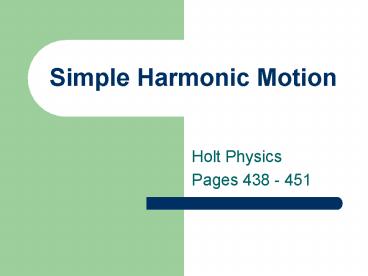Simple Harmonic Motion - PowerPoint PPT Presentation
1 / 28
Title:
Simple Harmonic Motion
Description:
Distinguish simple harmonic motion from other forms ... f frequency in vibrations / second or Hertz ... http://www.ngsir.netfirms.com/englishhtm/SpringSHM.htm ... – PowerPoint PPT presentation
Number of Views:118
Avg rating:3.0/5.0
Title: Simple Harmonic Motion
1
Simple Harmonic Motion
- Holt Physics
- Pages 438 - 451
2
Distinguish simple harmonic motion from other
forms of periodic motion.
- Periodic motion is motion in which a body moves
repeatedly over the same path in equal time
intervals. - Examples uniform circular motion and simple
harmonic motion.
3
Contd
- Simple Harmonic Motion (SHM) is a special type of
periodic motion in which an object moves back and
forth, along a straight line or arc. - Examples pendulum, swings, vibrating spring,
piston in an engine. - In SHM, we ignore the effects of friction.
- Friction damps or slows down the motion of the
particles. If we included the affect of friction
then its called damped harmonic motion.
4
Contd
- For instance a person oscillating on a bungee
cord would experience damped harmonic motion.
Over time the amplitude of the oscillation
changes due to the energy lost to friction. - http//departments.weber.edu/physics/amiri/directo
r/DCRfiles/Energy/bungee4s.dcr
5
State the conditions necessary for simple
harmonic motion.
- A spring wants to stay at its equilibrium or
resting position. - However, if a distorting force pulls down on the
spring (when hanging an object from the spring,
the distorting force is the weight of the
object), the spring stretches to a point below
the equilibrium position. - The spring then creates a restoring force, which
tries to bring the spring back to the equilibrium
position.
6
Contd
- The distorting force and the restoring force are
equal in magnitude and opposite in direction. - FNET and the acceleration are always directed
toward the equilibrium position.
7
Contd
- Applet showing the forces, displacement, and
velocity of an object oscillating on a spring. - http//www.ngsir.netfirms.com/englishhtm/SpringSHM
.htm
8
Displacement Velocity Acceleration
9
Contd
- at equilibrium
- speed or velocity is at a maximum
- displacement (x) is zero
- acceleration is zero
- FNET is zero (Restoring Force Distorting Force)
- object continues to move due to inertia
10
Contd
- at endpoints
- speed or velocity is zero
- displacement (x) is at a maximum equal to the
amplitude - acceleration is at a maximum
- restoring force is at a maximum
- FNET is at a maximum
11
State Hookes law and apply it to the solution of
problems.
- Hookes Law relates the distorting force and the
restoring force of a spring to the displacement
from equilibrium.
12
Contd
- F magnitude of the distorting or restoring
force in Newtons - k spring constant or force constant (stiffness
of a spring) in Newtons per meter (N/m) - x displacement from equilibrium in meters
13
Calculate the frequency and period of any simple
harmonic motion.
- T period (time required for a complete
vibration) in seconds - f frequency in vibrations / second or Hertz
14
Relate uniform circular motion to simple harmonic
motion.
- The reference circle relates uniform circular
motion to SHM. - The shadow of an object moving in uniform
circular motion acts like SHM. - The speed of an object moving in uniform circular
motion may be constant but the shadow wont move
at a constant speed. - The speed at the endpoints is zero and a maximum
in the middle. - The shadow only shows one component of the motion.
15
Contd
- Applet showing the forces, displacement, and
velocity of an object oscillating on a spring and
an object in uniform circular motion. - http//www.ngsir.netfirms.com/englishhtm/SpringSHM
.htm
16
Identify the positions of and calculate the
maximum velocity and maximum accelerations of a
particle in simple harmonic motion.
- The acceleration is a maximum at the endpoints
and zero at the midpoint. - The acceleration is directly proportional to the
displacement, x. - The radius of the reference circle is equal to
the amplitude. - The force and acceleration are always directed
toward the midpoint.
17
- Fmax Force (N)
- m mass (kg)
- A - Amplitude (m)
- T period (seconds)
18
Contd
- This equation shows that the spring force
according to Hookes Law is equal to the maximum
force the spring experiences. K cancels on both
sides.
19
Contd
- k spring constant (N/m)
- m mass (kg)
- T period (s)
20
Contd
- Vmax maximum velocity (m/s)
- A amplitude or maximum displacement (m)
- T period (s)
21
Contd
- Vmax maximum velocity (m/s)
- A amplitude or maximum displacement (m)
- T period (s)
22
Contd
- a acceleration (m/s2)
- v velocity (m/s)
- A amplitude (m)
23
Contd
- a acceleration (m/s2)
- A Amplitude(m)
- T period (s)
24
Contd
- T period (s)
- m mass (kg)
- k spring constant (N/m)
25
(No Transcript)
26
Relate the motion of a simple pendulum to simple
harmonic motion.
- A pendulum is a type of SHM.
- A simple pendulum is a small, dense mass
suspended by a cord of negligible mass. - The period of the pendulum is directly
proportional to the square root of the length and
inversely proportional to the square root of the
acceleration due to gravity.
27
Contd
- Applet of displacement, velocity, acceleration,
force, etc acting on a pendulum. - http//www.walter-fendt.de/ph11e/pendulum.htm
28
Contd
- T period (s)
- l length (m)
- g acceleration due to gravity (m/s2)































